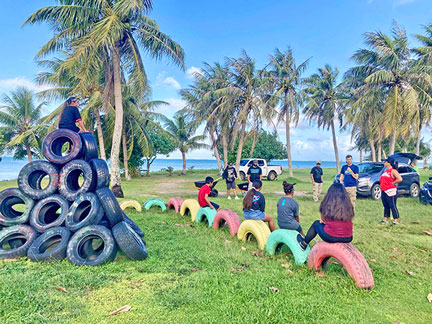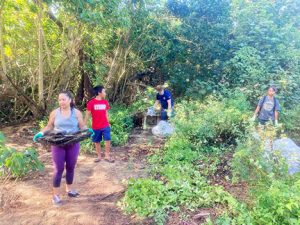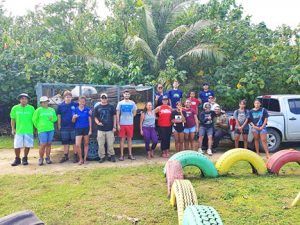The Tanapag Beach Cleanup
Starting the year clean and right!

Rep. Sheila Babauta (D-Saipan) and Coastal Resources Management watershed coordinator Zachary Williams briefing some student volunteers about the area and the importance of keeping it clean, prior to the cleanup. The group was able to collect 2,120 lbs of trash in the less than three hours of cleanup held last Monday, at the Dogas Stream/Tanapag Beach Park, at the Beach Cleanup jointly organized by the Bureau of Environmental and Coastal Quality and the Office of Rep. Sheila Babauta, with the Micronesia Islands Nature Alliance. (Iva Maurin)
The CNMI is kicking of the year “clean and right” with community volunteers coming together to pick up trash, to rid the islands off of pollution that harm not just the environment, but all of us that depend on it.
In less than three hours, literally a ton of trash was collected and picked up by the volunteers, mostly local students, last Monday, Jan. 4, in Tanapag, at a beach and stream cleanup jointly organized by the Bureau of Environmental and Coastal Quality and the Office of Rep. Sheila Babauta, with the Micronesia Islands Nature Alliance.
Hauled, from the Tanapag Beach Park to the Dogas Stream area, were varying types of trash, mostly heavy rusty tin roofs and electric fan guards, sinks, and refrigerator parts. This, according to some volunteers, is very disappointing considering that the transfer station is only a few blocks away.
“The Dogas Stream is an important ecosystem that we must continue to raise awareness for and encourage our community to protect. The Tanapag Beach Park is a place we all enjoy as a community. We want to keep these places clean for our community and for future generations,” Babauta (D-Saipan) said.
The legislator represents the district where the cleanup was held.
Not a dumpsite
Babauta shared that she has received numerous complaints of an abandoned boat on the area that is being used as a dumping site.
“The community members who come to me are concerned about the impact it has on our environment, especially with it being so close to the beach. The illegal dumping ground isn’t just unsightly and unsafe, it threatens the health of our marine life.”
She also pointed out that the area, if not maintained, could endanger wildlife and cause harm to everyone. “Our community members frequent these areas to fish and spend time with their family and friends. We must remember that we’re all connected. If the fish eat plastics, we eat plastics (because we eat the fish).”

Community volunteers, including local students, pick up trash along the Dogas Stream and at the Tanapag Beach Park last Monday, Jan. 4, at the Beach Cleanup jointly organized by the Bureau of Environmental and Coastal Quality and the Office of Rep. Sheila Babauta, with the Micronesia Islands Nature Alliance. (Iva Maurin)
While there have been beach cleanups on island, most tend to be more on popular tourist beaches, and the Dogas Stream, Tanapag area, do not get as much attention. It is important to note, however, that “prevention is always better than cure” – meaning, it is better to not dump trash just about everywhere, than to pick them up after.
“I want our community to remember how beautiful our island is and to cherish that memory for our children and future generations. I’m so grateful to our community members who make the effort to pick up trash, take trash home, and to properly dispose of waste. We must take responsibility for our impact, be considerate of others, and have respect for our home.”
Babauta also expressed appreciation to all who make the effort to keep our CNMI beautiful, and asked everyone who are having issues with waste disposal to reach out to the legislators.
“Come to us, your leaders. Come to us with your issues—and your solutions. This is a collective effort.”
Important estuary
The Dogas Stream is among the largest and most consistent estuary ecosystems on island, and perhaps, the most northern mangrove habitat, where fish sightings have been documented.
According to Division of Coastal Resources Management Watershed coordinator Zachary Williams, estuaries are very productive biodiversity ecosystems which serves as an important nesting habitat, or home to some species.
“It’s really important that we keep that area clean,” Williams said. “Mangrove and estuary habitats serve as important habitat for native species and fishery species too. We’ve documented things like trevally, emperors, and mullets, all using that habitat. It’s important for our biodiversity, but also for our fisheries, our subsistence, our economy.”

Volunteers, with Rep. Sheila Babauta (D-Saipan), and staff of the Bureau of Environmental and Coastal Cleanup and the Micronesia Islands Nature Alliance, gamely posing in front of the truck filled with some of the collected trash. The group was able to collect 2,120 lbs of trash in the less than three hours of cleanup held last Monday, at the Dogas Stream/Tanapag Beach Park. (Contributed Photo)
“It’s used by a lot of our fishes here—juvenile trevally, emperors, mullets, [along with] some other native stream or brackish species like flagtail (fish), native shrimps and crabs, and birds. It’s great habitat for the white eye, fantail, fruit dove, and white-throated ground dove.”
An estuary, he explained, is where a river or stream meets a larger body of water, in the CNMI’s case, the ocean. It is where the freshwater of the stream mixes with the saltwater of the ocean, and creates a brackish water – a mixed water environment that is a unique interface of the land and sea.
“It’s so easy to pollute the water there. Since it’s where it’s the end of the stream, it’s not only when you dump garbage or waste in there you’re polluting it, but it’s also where the entire length of the stream is.”
“Eventually, all that pollution is going to pass through that one point. So it’s shouldering the entire stream’s worth of pollution, which eventually flows out to sea. Any waste that gets in there, of course, is going into the sea, the seagrass, the reef,” he added.
Williams also said that in degrading the habitat, including taking out vegetation, clearing mangroves, we are reducing its own capacity to clean the water and filter out pollutants, as well as provide habitat shoreline protection.
Invest in nature
The 2,120 lbs of trash collected by the volunteers in less than three hours at Tanapag last Monday seems a lot especially in comparison to the over 9,000 lbs collected all over the island during the entire coastal cleanup last year.
Clearly, there needs to be an even more serious environmental protection campaign on island, and more involvement from all sectors, especially the community. Williams highlights the importance of outreach activities, such as the one held in Tanapag, to keeping the environment healthy.

A ton of wastes, 2,120 lbs of trash to be exact, were collected by the volunteers in less than three hours at the Dogas Stream/Tanapag Beach Park area, which were then hauled to the Transfer Station nearby shortly after the cleanup. (Iva Maurin)
“This is a great opportunity for the community, particularly the youth, to to be involved in natural resource management in their community, and hopefully become more invested in maintaining, managing, and keeping their natural resources clean.”
As for those who keep dumping trash illegally, and wantonly disregarding littering laws, Williams is appealing for them to stop.
“Please stop. It’s all of our backyard. It’s beautiful habitat. It’s a beautiful island and we want to keep it clean. It’s a lot more work to pick trash up than it is to throw it out, so please, please don’t throw it out. It causes so many problems and it’s so difficult to clean. Keep Saipan clean, let’s have a plastic-free Marianas.”
For more information about waste management, or to volunteer in the community cleanups, contact the BECQ office at 664-8500/1.























